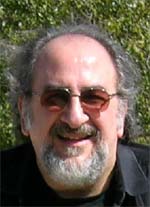Anthony E. D'Agostino, 2009 Distinguished Service Award
 Tony D’Agostino was born in Chicago and grew up in a blue-collar neighborhood in the western suburbs. At a young age, he acquired a voracious appetite for reading, particularly science fiction from the "Golden Age." The influence of Asimov, Heinlein, and others gave him an early interest in science, and despite the absence of anything within miles of his home that resembled an outcrop, he developed a particular interest in geology. In high school he enthusiastically participated in spring break geology field trips as a member of the Science Club. In 1970 during one of these trips, to the Kettle Moraine area of Wisconsin, he discovered his pet rock "George Stone." This discovery predated the commercial pet rock craze later in that decade. Had Tony anticipated the economic potential of his discovery at that time, we may not have him around doing geology today. George is still prominently displayed in Tony's home office.
Tony D’Agostino was born in Chicago and grew up in a blue-collar neighborhood in the western suburbs. At a young age, he acquired a voracious appetite for reading, particularly science fiction from the "Golden Age." The influence of Asimov, Heinlein, and others gave him an early interest in science, and despite the absence of anything within miles of his home that resembled an outcrop, he developed a particular interest in geology. In high school he enthusiastically participated in spring break geology field trips as a member of the Science Club. In 1970 during one of these trips, to the Kettle Moraine area of Wisconsin, he discovered his pet rock "George Stone." This discovery predated the commercial pet rock craze later in that decade. Had Tony anticipated the economic potential of his discovery at that time, we may not have him around doing geology today. George is still prominently displayed in Tony's home office.
Tony began his lifelong tradition of service to geological organizations when he was elected President of the Geology Club at Illinois State University. This was just a couple of weeks after his arrival at the university, and he was required to join the club after the election to take office. He graduated in 1978 with a BS in Geology, and continued on to graduate school at Northern Illinois University. While there, he studied under the renowned Antarctic researcher Peter N. Webb. In 1980, upon completion of his thesis on Miocene foraminifera from the Ross Sea, he was awarded an MS in Geology and accepted a job as a biostratigrapher at ARCO in Houston.
In his early years at Arco, Tony concentrated mostly on the difficult Paleogene section of the Gulf Coast. In 1982, he spent 2 months at sea as a Shipboard Scientist on DSDP Leg 86 (Shatsky Rise and NW Pacific). This Leg collected some of the first physical evidence supporting the impact theory for the K/T boundary event. That same year Tony joined GCSSEPM. During the course of his career at ARCO, Tony was exposed to a broad range of experiences that gave him a unique perspective on applied stratigraphy. This perspective enables him to provide groundbreaking influence to our society's functions.
In 1984, Tony was the first person to bring a core to a GCSSEPM Research Conference, Habitat Of Oil and Gas, where he displayed the East Seven Sisters Wilcox core. He presented another paper and brought more Wilcox core to John Armentrout's 1990 GCSSEPM sequence stratigraphy conference (rerun in June 1991).
In 1991, Tony left the Gulf Coast region, moved to Midland, and jumped into active participation in the Permian Basin Section. His service as a member and an officer of that section is legendary, but is not a part of the present story. While in Midland, Tony broadened his skills by acquiring expertise in conodonts and doing extensive work with carbonates. He left ARCO and worked several years as an independent consultant in Midland. His consulting work gave him the opportunity to apply his skills not only to the Western Interior of the US, but also to Mexico and Venezuela.
In 1997 he accepted a job with PGS and returned to Houston. He immediately resumed active participation in GCSSEPM activities. In 1999 he began regular GCSSEPM participation in Earth Science Week at the Houston Museum of Natural Science. In 2000 he served as GCSSEPM Vice-President, as President-Elect in 2001, President in 2002, and Past-President in 2003. During his term as President he initiated (with Robert Nail and Norm Rosen) the redesign and upgrade of the Section web pages. Participation in Earth Science Week also became a permanent duty of the President-Elect during Tony's tenure in that position.
After another year as an independent contractor, Tony accepted a position as Biostratigraphic Coordinator with Omni/Weatherford labs. During his tenure there he pioneered the use of bio- and sequence-stratigraphic principals in unconventional plays. He continued his activities with the GCSSEPM by presenting a third Research Conference paper on Permian dolomite reservoirs from West Texas in John Armentrout's 2002 sequence stratigraphy conference.
In 2008, Tony left Weatherford Labs and accepted a position working unconventional resources with Hess Corporation. Also in 2008, the GCSSEPM Executive Council elected Tony to a 4-year term on the GCSSEPM Foundation Board of Trustees. Finally, in 2009 Tony sat on the conference committee, and acted as coeditor for the Bob F. Perkins Research Conference on Unconventional Resources.
Tony has contributed and continues to contribute to both the GCSSEPM and to the science of geology. His dedication to service has been essential to the success of our organization throughout the years, and he has well earned the Distinguished Service Award.
Mike Styzen
